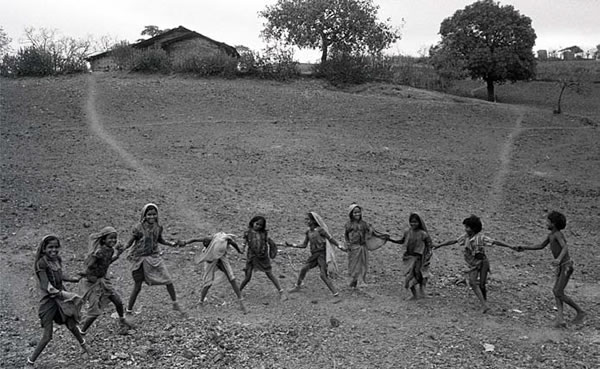Let 100 Flowers Bloom – Binoy Varghese
Indira Lakshmi Prasad
The works as a collection do not have individual titles, but are all grouped under the title ‘Let 100 flowers bloom’ Its one story under one title, consisting of around 13 paintings.
The title itself is a quote from Mao Zedong, the chairman of the communist party of China in reference to the ‘Hundred Flowers Campaign’ which originated from the quote “Let a hundred flowers bloom; let a hundred schools of thought contend”. The idea was to have intellectuals discuss the problems of the country and promote new forms of art and cultural initiatives. The artist was inspired by this quote as a central piece of history the people’s revolutionary movement in China. 
The artists work also delves into the recent history of revolution in various parts of the world, such as the ‘Arab Spring’ which refers to the democratic uprising which arose amongst the Arab world in 2011 and also the pronounced history of peoples revolutions which have taken place across several African countries over the decades. The artist considers how these different revolutionary movements have affected his home country of India, and the rest of the globe, because it’s a known fact that, as happened in the Arab Spring, revolution often grows and spreads through connectivity of the working classes. This phenomenon doesn’t only inspire and affect individuals in the same country but has a knock-on effect to other nations as solidarity occurs between the global working classes. It is this global connectivity which becomes the ideological backdrop of the work.
The artist also reflects upon the way India as a nation is adopting the tendency of protest and uprising against social oppression, as globalization has occurred so has the spread of ideas and connectivity in the consciousness of the working classes. The artist states that the 2016 student uprising at JNU where student groups protested against the capital punishment meted out to the 2001 Indian Parliament attack convict Afzal Guru and the Kashmiri Separatist Maqbool Bhat, as an inspiring force behind his works. The organizers of this particular event were former members of the Democratic Students Union (DSU) and defiantly continued the event following the university administration withdrawing permission following protest from the Hindu Nationalist Student Union (AVBP). This culture of political activism continues to thrive at JNU despite the charges pressed against students after this particular incident, and the JNU Student Union continues to have links with the Communist Party of India, despite the restrictions on freedom of speech which are at times present under the current government.
Several of the pieces in the ‘Let 100 Flowers Bloom’ series are inspired by the physical nature of individuals coming together to protest in open spaces. Binoy Varghese takes photographs while travelling abroad and in India, and then uses several photographs to create collage type image boards which he then transfers into painted image with acrylic on canvas. He uses a traditional method of cutting and pasting the hard copies of the photographs rather than digitally rendering them before enlarging on the canvas. The finished result is a layered (around 7 or 8 layers of color is applied before a piece is finished) and visually intriguing composition. Perhaps most interestingly is the fact that the images layered together are often from two or three different parts of the world, and often different scales are amalgamated together to form surreal landscapes.
Binoy Varghese travels to different countries, mainly in Asia, the Middle East and Africa, and takes photographs while on location. It is these photographs collected while travelling that the artist uses to create the collages which he then enlarges onto canvas.


